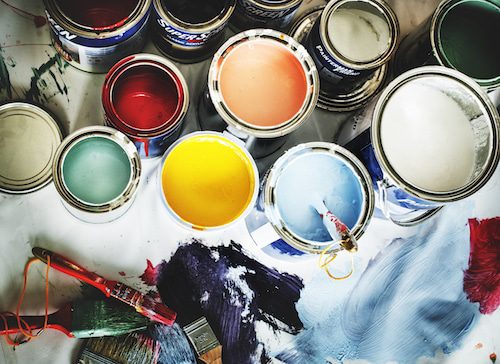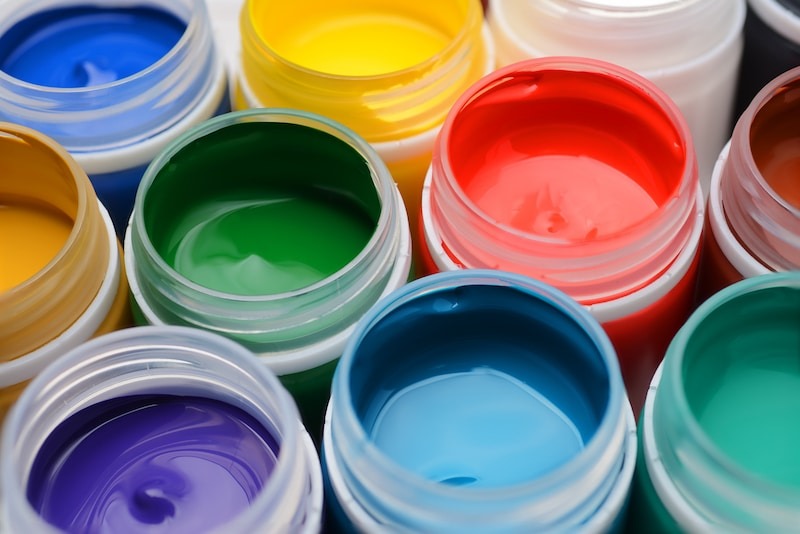
Until you experiment each paint separately for a while, it can be very challenging to determine the right paint to use for your interiors between oil and acrylic. Regardless of whether you are an experienced painter or just a beginner, the decision about choosing the right paint to use for your interior painting is critical. Oil and acrylic paint are the most commonly used.
Oil paint is a slow-drying paint that is composed of hanging pigment particles of a drying oil commonly known as linseed oil. The viscosity of oil paint can be manipulated by adding solvents such as white spirit or turpentine.
Acrylic paint, on the other hand, is quick drying and contains acrylic polymer emulsion pigment. It can be diluted with water although it can become water-resistant after it dries out.
To completely grasp the difference between the two types of paint and determine which is suitable for interior painting, we must examine the pros and cons of each.
Acrylic Paint
Pros of Acrylic Paint
- You can use acrylic paint on any surface you want. This makes it an excellent medium to experiment. You can paint it on paper, canvas board or card and whatever you can lay your hands on. It is the right paint in case you work quickly. The brushes you use need to be cleaned in less than 10 minutes or else it will dry out and become stubborn.
- Acrylic paints leave a crisp edge. This is vital in case you like painting with a lot of graphic composition. You can mask out some areas then work over them fast. The paint makes it easy for you to mix bright and clean colours.
- Acrylic doesn’t fade fast. It is lightfast and the colour it leaves behind can look the same for as long as 200 years. The acrylic polymer pigment doesn’t yellow with time like the case of oil-based paints.
- It is very flexible and great if you love creating thick paintings using a palette knife. You can do thick painting while still letting the paint to dry out properly. For the case of oil, outer surfaces can dry while inner remains wet.
- Acrylic is non-smelly and non-toxic. If you plan to work in a confined space where there’s no proper ventilation, then it is an excellent alternative.
- Acrylic is cheaper than oil. In case you are on a tight budget, you can pick acrylic.
Cons of Acrylic Paint
- It dries out too quickly. This leaves you with no time to make changes in case there is an emergency. In case of a slight delay, the paint will be unable to shift any longer. Furthermore, the quick drying time makes it hard to achieve a smooth blend. It is difficult in case you’re working on a large interior surface. To increase the drying time, you can add a medium like a gloss, soft gel or retarder.
- Although acrylic retains colour for long, they are prone to change their colour once they dry up. The white binder tends to become clear when dry.
- They can crack in extremely cold environments.
Read next: How to Paint a Ceiling the Right Way – 9 Easy Steps
Oil-based Paint

Pros of Oil Paint
- It gives you a longer working time. You can paint today then come back a day later to continue right from where you stopped. The paint remains pliable and wet for long compared to acrylic. Additionally, the long drying time is fantastic as it allows you to add thin glazes to improve the luminosity of your surface once the paint dries out.
- It is ideal for blending colours. Due to the slow drying time, the paint is good for achieving smooth blends.
- Even though they shift in colour, oil paints don’t change their colour quickly. The areas that appear dull is often caused by too little oil.
- You can over-paint a surface without necessarily disturbing the underlying layer provided it is dry.
- Oil paints have higher pigment in them thus providing richer and vivid colours.
- It is easier to mix oil paints than acrylic. This is because of the quick drying time of acrylic paints.
Cons of Oil Paint
- The strong odour meaning you need to work in a well-ventilated area. For instance, white spirit and turpentine can be really odorous.
- They have a slight yellowing tinge depending on the colour of the oil used.
- You have to wait for it to dry in case you want to create a crisp edge otherwise brushstroke will mix and interfere with the paint underneath.
If you are a slow, cautious and deliberate painter, then oil would be ideal for you. However, due to the strong smell, you’ll have to open all the doors and windows for ventilation. If you don’t want the toxicity of oil and want something that dries up quickly, then acrylic would be appropriate.
Regardless of the paint you choose, you can trust Newline Painting to provide a comprehensive range of custom interior painting service. Please do not hesitate to contact us over the phone for a free quote, colour consultation, paint design and much more. You can reach our friendly staff at 1300 044 206 to book your Melbourne house painting needs. Our services such as bedroom painting, driveway painting, and pre sale house painting are available throughout Melbourne, including Collingwood, Dandenong, Elwood, Essendon, and Fitzroy. Did you like this article breaking down the differences between acrylic and oil paint? Here’s one on The Differences of Ceiling and Wall Paint.







